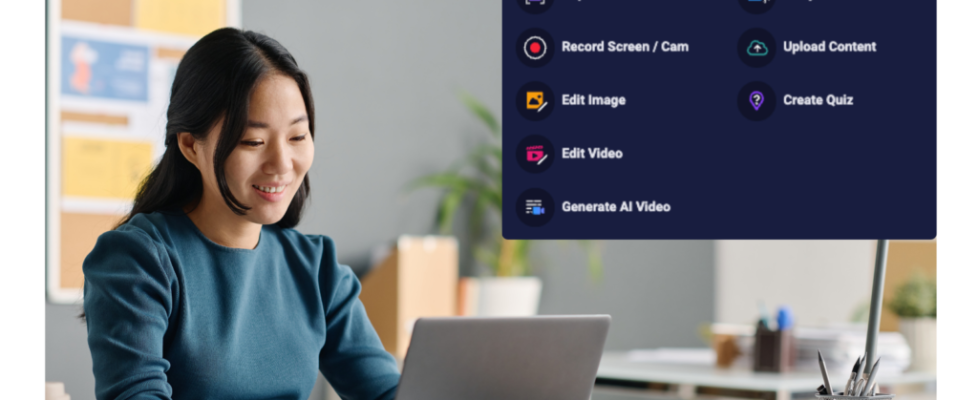“I love to learn, and I’m fascinated by the learning process of every level,” says Karen Costa, an author, and higher ed professional.
Costa has been working in higher ed since 2002. Her current work revolves around supporting faculty with their online pedagogy. She also specializes in trauma-aware teaching, which helps educators to better understand how stress and trauma affect learning.
No matter where she is in her career, she teaches the importance of video learning. She’s seen first-hand the positive impact it has made on her students.
The Impact of Video
“I noticed that when I create video tutorials, the quality of students’ submissions is greatly increased,” she says.
The higher ed professional has been creating videos since 2007 and has implemented them in her courses for both students and teachers. “Once I started making videos for my learners, I never stopped,” she says.
There’s only been one time she had to teach a course without using videos and she saw the impact right away. “I taught one term without videos in the past fourteen years (due to some course development changes), and it fell flat. There was very little life in that course.”
Her goal now is to teach others how to use and engage with video. In her book ‘99 Tips for Creating Simple and Sustainable Educational Videos: A Guide for Online Teachers and Flipped Classes,‘ she provides educators easy tips on video creation. It’s something she’s mastered over the years.
Her Approach For Creating Video
 Costa believes that building a connection through her videos matter. “My learners, both students and faculty, tell me that they get to know me through my video. They feel connected to me, even if we’ve never shared the same physical space.”
Costa believes that building a connection through her videos matter. “My learners, both students and faculty, tell me that they get to know me through my video. They feel connected to me, even if we’ve never shared the same physical space.”
Videos help her students and faculty get to know her. It helps create a sense of connection even if they’ve never met in-person. Costa believes videos help bring her courses to life, even when they aren’t flawless.
She doesn’t give in to the pressure to make fancy videos, instead, Costa favors a high-connection, low-production approach.
“I make short, simple videos where I speak from the heart,” she says. “I’ve found that these videos contribute to a warm classroom climate.”
Even if you make mistakes, she says to keep going. “When you take the pressure off, when you allow yourself to make a mistake and keep going, and to just have fun with the process, it’s much more sustainable,” she says. “When we prioritize the connections over the production value, we end up with videos that humanize us and our online classrooms.”
Over time, Costa realized the mistakes are often her favorite part of her videos. They enable her to show students how she accepts her mistakes but to keep on going. “What more valuable lesson could I share with my students?” she asks.
Video Learning Tools
Costa believes we should create spaces that benefit both faculty and students. “We know that faculty success leads to student success,” she says. “It is also worthy in its own right.”
A screen recorder is one of her favorite ways to make learning work for everyone.
“I like simple and sustainable,” she says. “In my travels, I stumbled on ScreenPal. I love it because it’s a tool I was able to teach myself in a few minutes and start using immediately. It’s intuitive.”
Like many teachers, sometimes Costa doesn’t feel like being on camera. On those days, she sets the screen recorder to record her screen so she can take a break from her webcam. It’s one of her favorite tips to share with camera-shy teachers because it still gives them a way to connect with students and make compelling content.
She creates quick videos answering frequently asked student questions, and gives assignment overviews. While it takes time upfront to record videos, she saves time in the long run because she spends less time repeating herself. Plus, she can recycle the video clips for future classes.
Why Video Learning Is Here to Stay
Costa predicts that hybrid learning will become the norm after the pandemic with face-to-face courses mixed in with a lot of online elements including video.
She believes that video will only grow in importance as a learning tool thanks to its time-saving and connection-building superpowers.
“Both students and teachers appear to benefit from videos in that there is a greater sense of connection when we can see and hear each other,” she says.
Costa urges educators to be prepared for instability in the years to come. “Education is going to need to adapt to the needs of our learners in this increasingly uncertain environment,” she says.
She advises educators to take it easy and to seek support within their communities.
Quick Resources
 You can find Costa’s book ‘99 Tips for Creating Simple and Sustainable Educational Videos: A Guide for Online Teachers and Flipped Classes‘ on her website at 100faculty.com.
You can find Costa’s book ‘99 Tips for Creating Simple and Sustainable Educational Videos: A Guide for Online Teachers and Flipped Classes‘ on her website at 100faculty.com.
You can view a list of videos on her YouTube channel.
Read more of her video creation tips at ‘5 Expert Tips to Take the Stress Out of Video Creation.’

































